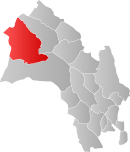Hol
| Hol kommune | |||
|---|---|---|---|
| Municipality | |||
|
|||
 Hol within Buskerud |
|||
| Coordinates: 60°34′18″N 8°4′18″E / 60.57167°N 8.07167°ECoordinates: 60°34′18″N 8°4′18″E / 60.57167°N 8.07167°E | |||
| Country | Norway | ||
| County | Buskerud | ||
| District | Hallingdal | ||
| Administrative centre | Hol | ||
| Government | |||
| • Mayor (2003) | Erik Kaupang (Ap) | ||
| Area | |||
| • Total | 1,858 km2 (717 sq mi) | ||
| • Land | 1,664 km2 (642 sq mi) | ||
| Area rank | 36 in Norway | ||
| Population (2004) | |||
| • Total | 4,556 | ||
| • Rank | 211 in Norway | ||
| • Density | 3/km2 (8/sq mi) | ||
| • Change (10 years) | -1.5 % | ||
| Demonym(s) | Holing | ||
| Time zone | CET (UTC+1) | ||
| • Summer (DST) | CEST (UTC+2) | ||
| ISO 3166 code | NO-0620 | ||
| Official language form | Neutral | ||
| Website | www |
||
|
|
|||
Hol is a municipality in Buskerud county, Norway.
The area of Hol was separated from the municipality of Ål in 1877 to become a separate municipality. In 1937 a part of neighboring Uvdal with 220 inhabitants was moved to Hol municipality. The area of Dagali was transferred from Uvdal to Hol in 1944. In 1962 Uvdal was reunited with Nore to form the new municipality of Nore og Uvdal.
The municipality (originally the parish) is named after the old Hol farm (Old Norse: Hóll), since the first church was built here. The name is identical with the word hóll, which means "round (and isolated) hill".
Hol is bordered to the north by Lærdal, to the north and east by Ål, to the south by Nore og Uvdal, and to the west by Eidfjord, Ulvik and Aurland. Hol is a mountainous area, where over 90% of the area is at an altitude exceeding 900 meters above sea level. The Hallingskarvet mountain range is the highest point in the municipality, at 1933 meters above sea level. The Usta or Usteåne River flows northeast from Lake Ustevatn traveling down the Ustedalen valley. The Hallingdalselva River is formed by the confluence of the Usta River and the Holselva River from Lake Strandavatnet.
The coat-of-arms of Hol is from modern times; the arms were granted on 5 July 1991. They show three silver anvils on a blue background and were designed by Trond Andersson. The three anvils are stacked one above the other, with the top one being largest and the bottom one smallest. The anvil was chosen to symbolize the former smithies in the municipality, which were famous for the production of axes, blades, and knives. Iron mining was already practiced in the area in the Viking Age.
...
Wikipedia


